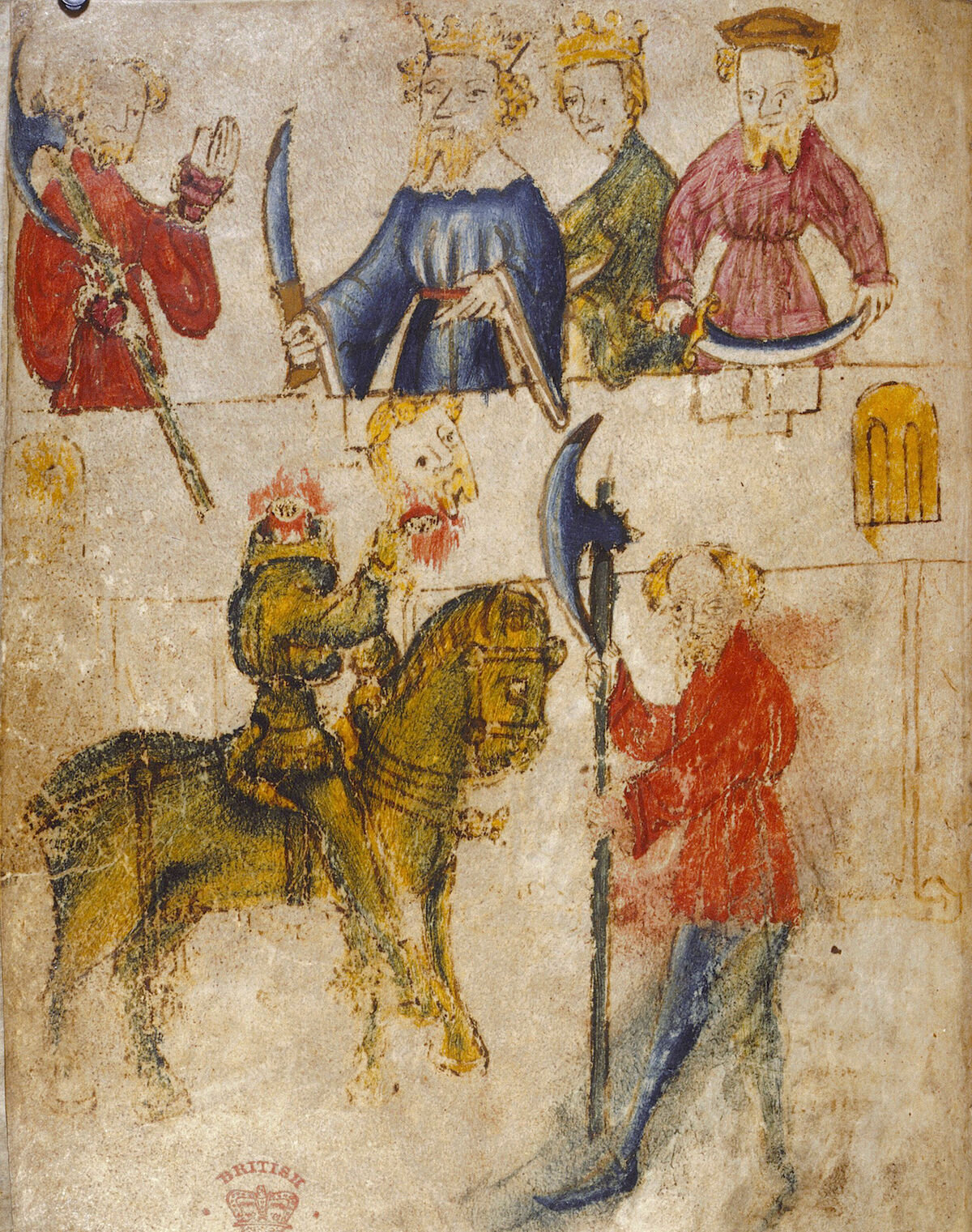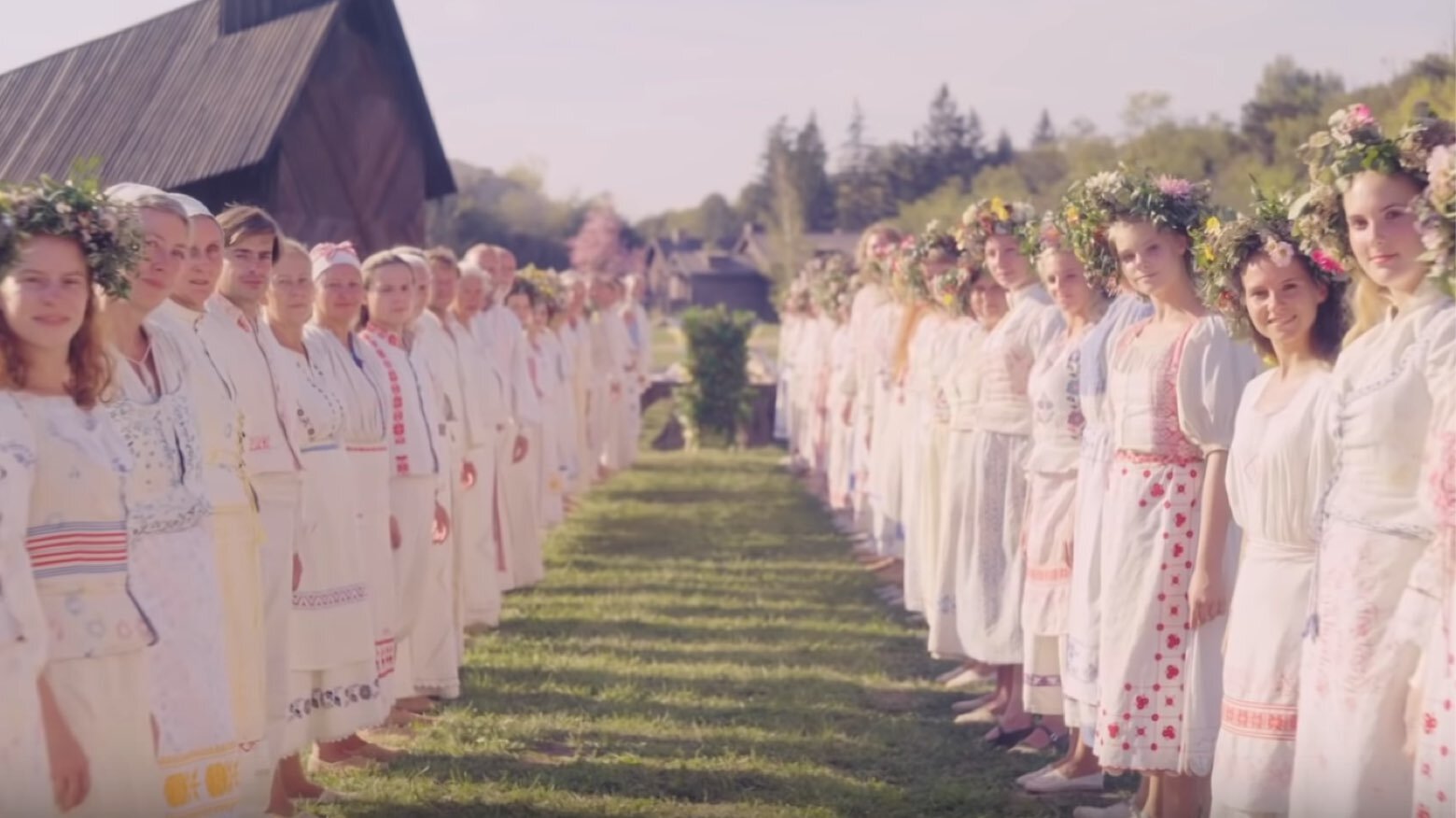Mythology at the Movies: Sir Gawain and the Green Knight
by Ryan Silberstein, Managing Editor, The Red Herring
Welcome to Mythology at the Movies, a new monthly(?) column where I will combine two of my biggest interests in order to attempt a better understanding of both. I am relatively new to studying mythology, and also feel like I am still a relative novice on my film journey, so this column is designed to further that mutual exploration! I hope this will be of interest to both those further along on their journeys and those just starting on the path. For this first entry, I am looking at a few movies that have connections to “Sir Gawain and the Green Knight” in anticipation of David Lowery’s new adaptation coming out on Friday.
Background: What is the myth?
Sir Gawain and the Green Knight is a chivalric romantic poem dating back to the late 14th century. Written in Middle English, we know of it from a single manuscript. The poem starts on New Year’s Eve, when a knight clad in green bursts into the halls of Camelot with an axe in one hand and a bough of holly in the other. He challenges the knights in attendance to a game: the one who accepts will strike him with his axe, and the Green Knight will return the blow in a year and a day. Gawain, Arthur’s nephew, accepts, beheads the knight. The knight retrieves his head, tells Gawain to meet him in a year and a day at the Green Chapel, and leaves.
As the date approaches, Gawain comes across a splendid castle, with a lord and his beautiful wife. They tell him the Green Chapel is not far, and to rest before he goes to meet the Green Knight. While there, the lord proposes that he will give Gawain whatever he brings back from hunting as long as Gawain gives him whatever he has received during that time. While the lord is out, his wife attempts to seduce Gawain, giving him a kiss, which Gawain returns. This happens twice more until Gawain sets off to the Green Chapel armed with a sash the wife bestowed on him. When he confronts the knight, he is only given a small neck wound, and the Green Knight is revealed to be the lord of the castle. He tells Gawain this was all a test by Morgan le Fay in an attempt to show Arthur’s knights lacking courage and honor, but he has passed the test, and the two part on good terms.
What does the myth mean to us today?
While chivalry itself is no longer something we practice, the core of the story is about acting in a way that is morally and ethically right. It is also about speaking the truth, no matter how uncomfortable. The core of the story is about interlocking promises and challenges to those promises. Gawain must keep his promise to let The Green Knight strike a blow in a year and a day as well as his vow of chastity in not letting the lady of the castle seduce him. He does not know that the latter promise will determine the outcome of the former, which makes it a blind test of his morals.
One of the reasons that “Sir Gawain and the Green Knight” is studied and discussed even today is because there are so many readings and interpretations beyond the literal meaning of the text. There are feminist and queer readings, deep dives into the meaning of various symbols and actions within the story, as well as a multidue of other interpretations. While the poem has been adapted to the screen (as well as other media) a few times, for this column I wanted to focus more on less literal incarnations of this story.
Echoes of “Sir Gawain and the Green Knight” at the movies
When the first trailer for David Lowery’s upcoming adaptation was released, many noted some visual resemblance to Ari Aster’s Midsommar also from film hipster favorite A24. Florence Pugh’s character Dani stands in for Gawain, and the remote Swedish cult stands in for The Green Chapel. Dani and the other non-cult members she is traveling with, including her boyfriend Christian (Jack Reynor), are all given explicit rules and instructions to follow during their experience at the Hårga. While the others keep their emotional distance from the cult, seeking to exploit the Hårga for their academic gain, Dani connects with the community on an emotional level. Her past trauma gets worked through via ritual, which itself is a folkloric tradition that often overlaps with mythology.
Aesthetically, Midsommar also evokes some of the imagery in the original poem. In reading the text (I read the Bernard O'Donoghue translation for this article), I was struck by the contrast between the primal sense of nature juxtaposed with the chivalric virtues extolled by Arthur and his knights. The Green Chapel is almost an inverse of Camelot, a hole in the ground rather than a castle that points to Heaven, “an ugly oratory indeed, overgrown with weeds,” (line 2190). Similarly, the open grassy area of the Hårga is broad and horizontally oriented, while the city life of Dani is again one that has buildings rising up toward the sky. Gawain and Dani are challenged by something aligned more with nature and a natural state of being, something that seems more chaotic and unpredictable, even if it is also governed by plainly stated rules.
Unlike “Sir Gawain and the Green Knight,” Midsommar offers an ending with an ambiguous interpretation. While it is clear that Dani has survived many of the cult’s tests, becoming the May Queen, the final moments ask the audience to decide on the ethical and moral implications of Dani’s choices. Often, mythology like “The Green Knight'' is meant to be morally instructive, affirming the qualities we are to live in our own lives. Midsommar challenges this, flipping slasher movie rules to upend the typical line of victims. Instead of the ‘pure’ virgin living after the lone wolf killer offs a series of promiscuous teens according to arbitrary rules, this is a communal force judging people based on how they comply with what they see as simple requests. While Aster tries to complicate matters (in order to reverse the typical colonial narrative of many cult films as well), Dani’s choices–especially as compared to her boyfriend’s–always feel like the core of Midsommar. Like Gawain, she isn’t perfect, but her actions save her life even if she wasn’t aware those were the stakes of the game.
In Alex Garland’s Ex Machina, the Turing Test is substituted for the seduction and beheading games. Caleb (Domhnall Gleeson) ventures to a remote house where he is unwittingly placed into an experiment related to robots and artificial intelligence. At one point, he is even left questioning whether he is an artificial being himself. While many films related to robots–from Alien to A.I.–ask us to question the meaning and value of artificial lifeforms, the structure of Ex Machina and the tie to games both evoke “The Green Knight.” Caleb’s long journey to the home of CEO Nathan (Oscar Isaac) parallels that of Gawain’s journey to the castle of Bertilak de Hautdesert. There Gawain agrees to the exchange game, not knowing that it is really going to be a seduction game with him as the target. As Gawain and the Lord drink “and lingered and acted light-heartedly...for as long as it pleased them,” so did Caleb and Nathan, with the former unaware that they are in fact the object of the game (line 1113).
Ava (Alica Vikander )herself works as a stand-in for both the lady and the tale’s ultimate villain, Morgan le Fay. She is temptress, tester, and mastermind, while Caleb doesn’t even recgonize that she is the one he is actually playing against. Again, the imagery in Ex Machina also aligns with that of this medieval romance, with Nathan’s home visually similar to the way that Bertilak’s castle is described as surrounded by trees and “well-crafted casements that closed to perfection” in “The Green Knight” (line 792).
While Ex Machina is a science fiction tale, there’s no doubt in my mind that it owes a lot to this medieval romance as well. So much of the science fiction genre is asking big questions, the same as philosophers and storytellers have been asking for as long as humanity has existed. Just because some of these concepts seem more possible today doesn’t mean they haven’t been theoretically wrestled with, even if the answers hew too close to Christian theology for many of us living today. While the ‘Gawain poet’ wouldn’t know anything about computer code, they still were poking at the same questions. How does one act like a moral person when it seems both potential choices are wrong? Part of what makes Gawain falter a bit is that he doesn’t do more to resist Bertilak’s wife, and that he does take a girdle said to protect him from harm when he faces beheading by The Green Knight. If Gawain was more Christ-like, his humility would have won out over his sense of logic and reason, but the poet recognizes that this is a smaller sin, leaving Gawain with just a scratch rather than a full beheading. Adding robots doesn’t make these choices more or less easy, unless you’re Captain Kirk and you change the rules of the Kobayashi Maru test.
The final film I want to compare to “The Green Knight” is Indiana Jones and the Last Crusade. Lucas and Spielberg’s invocation of the Holy Grail gives the third entry in the franchise a natural alignment with Arthurian legends, While Gawain’s narrative here isn’t part of the Grail quest, the elder Dr. Jones (Sean Connery) chides his son for blasphemy and Marcus Brody (Denholm Elliot) says that the search for the Grail is the “search for the divine in all of us.” While Indy (Harrison Ford) sets out on his quest not to keep a promise but to find his father, the challenges of the Grail require him to use both his wits and pure intention.
This is most true in what is the Grail’s final challenge. When trying to leave the temple, the Grail falls into a crevice. Elsa (Adrian Doody) falls into the bottomless pit while trying to reach it. Indy almost does the same, but is rescued when his father finally calls him “Indiana” and not “Junior.” This final temptation is similar to Gawain’s neck wound, a small sin that is a reminder of the correct choice. The Last Crusade flips the narrative on chivalry more broadly. Instead of trying to conform to the values of acting in a Christ-like way, archeology is presented as a grounding in the material world–even when those objects have supernatural connections and powers. Chivalry was the search for heaven on earth, while Indiana Jones was searching for the humanity he never felt from his father. Both men had been tempted and challenged along the way by “games” including a seductress with a Nazi connection. The Grail had been Henry Sr.’s life goal, yet both men put their relationship above it, and thus are able to leave the collapsing structure and ride off into the sunset.
The idea behind this column is that mythology is everywhere, even when it isn't obvious. The stories that have been passed down to us survived in part because they resonated so much with our ancestors that they needed to be written down. I hope to keep exploring these connections in the future with other myths and other movies.








